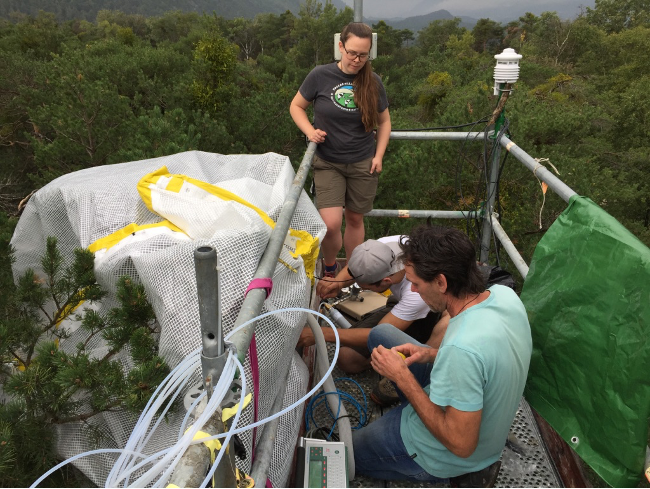A new paper that appeared in PNAS this month reveals strong effects of soil water availability on carbon transport in mature trees

The picture shows Corinne Bloch with collaborators of the WSL during the whole-canopy 13C-pulse-labelling experiment at Pfynwald. Corinne analyzed the tree-internal carbon transport and the allocation dynamics to carbon reserve pools in drought-exposed and irrigated trees as the topic of her master thesis.
Dry soils can significantly reduce the transport of carbon assimilates from the canopy to roots in trees. A new publication in PNAS describes the result of a large-scale 13C-labelling experiment with mature Scotts pine trees at the long-term irrigation experiment in Pfynwald (VS). The study, which was led by the Swiss Federal Institute for Forests, Snow and Landscape Research (WSL) in collaboration with the PPE group of the University of Basel, found that dry soils reduced the belowground transport of carbon in trees by over 50 % in comparison with trees that received regular irrigation during the growing season. A short rainfall event, that enhanced soil water contented in non-irrigated forest plots, immediately increased the amount of carbon transported to roots and the associated soil microbes to values comparable to those in irrigated plots. This study is the first experiment that could quantify the reduced allocation of recent assimilates belowground under naturally dry soil conditions in mature trees. It highlights the close interconnectidness of water and carbon relations in forest ecosystems.
Joseph, J., D. Gao, B. Backes, C. Bloch, I. Brunner, G. Gleixner, M. Haeni, H. Hartmann, G. Hoch, C. Hug, A. Kahmen, M. M. Lehmann, M. H. Li, J. Luster, M. Peter, C. Poll, A. Rigling, K. A. Rissanen, N. K. Ruehr, M. Saurer, M. Schaub, L. Schonbeck, B. Stern, F. M. Thomas, R. A. Werner, W. Werner, T. Wohlgemuth, F. Hagedorn, A. Gessler (2020) Rhizosphere activity in an old-growth forest reacts rapidly to changes in soil moisture and shapes whole-tree carbon allocation. Proceedings of the National Academy of Sciences USA 117: 24885-24892, https://doi.org/10.1073/pnas.2014084117
Quick Links
